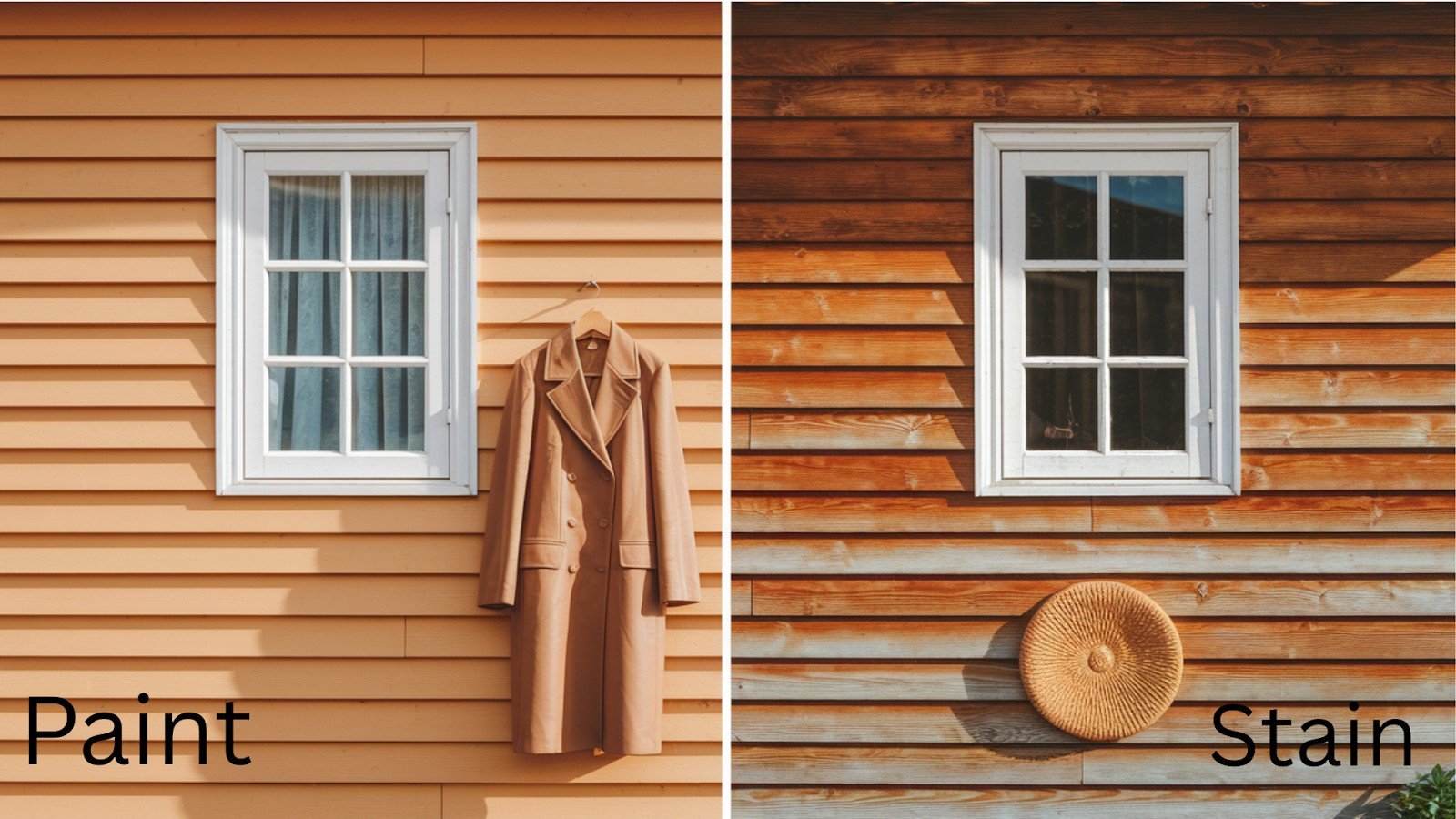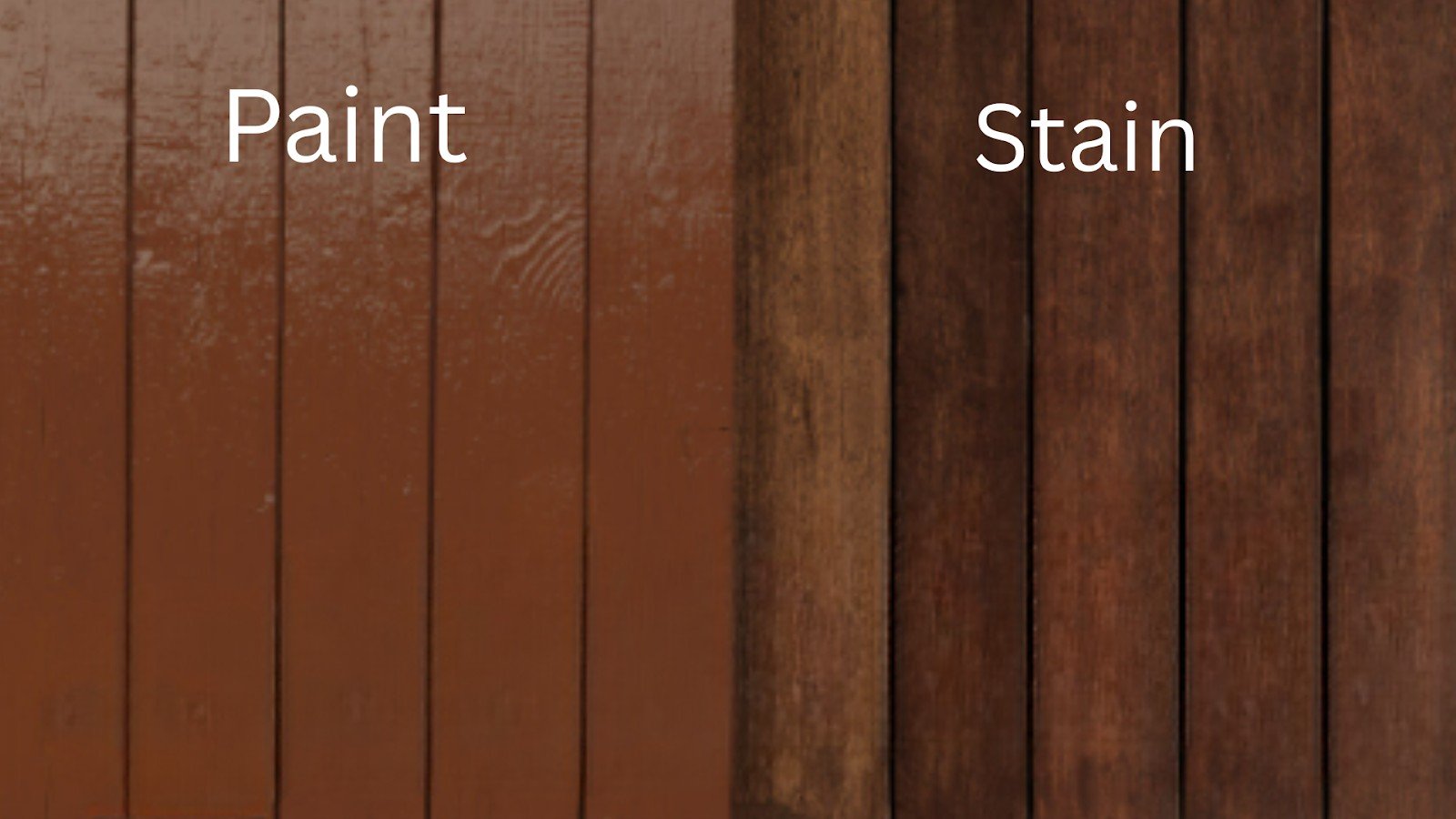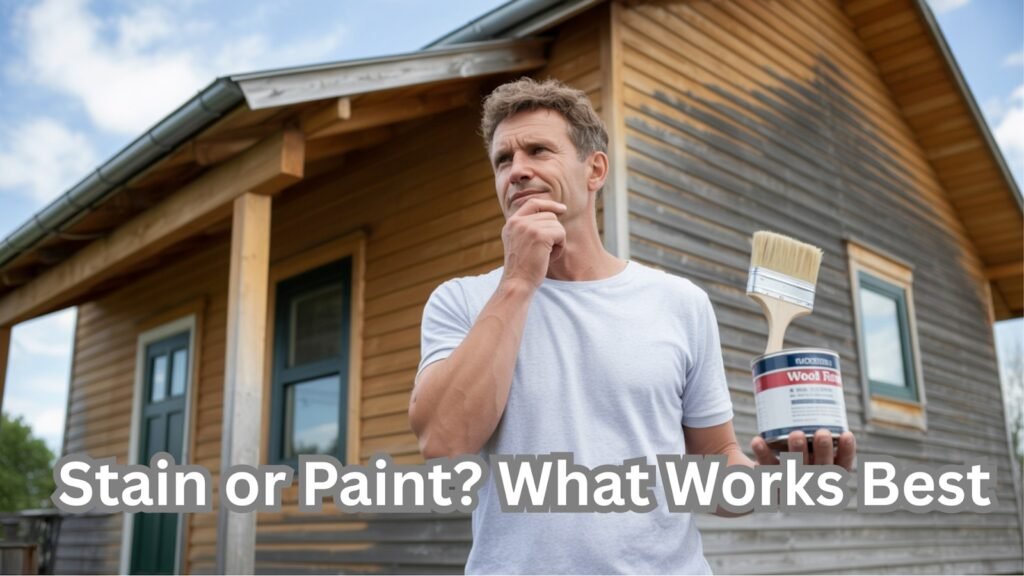When you’re standing in front of your home, looking at weathered wood siding or trim, the big question hits you: Should I use stain or paint?
It’s not just about looks. Your choice affects how long your finish lasts, how much you’ll spend, and how often you’ll be back out there with a brush in your hand.
Here’s what we’ll cover: How paint and stain work on wood, which option protects better against weather, real costs over time, and when to choose each option.
I’ve spent years helping homeowners make this exact decision. The truth is simple: there’s no one-size-fits-all answer. But there are clear guidelines that make the choice obvious once you know them.
You want your exterior to look great and last long. This guide gives you the straight facts to make the right call for your specific situation. Let’s sort this out together.
Paint vs Stain: The Essential Differences for Exterior Wood

Think of paint and stain as two different approaches to protecting your car. One gives you a shiny protective shell. The other soaks in and becomes part of the metal itself.
That’s exactly how these finishes work on wood.
How Each Product Works on Wood
Paint Creates a Protective Barrier
Paint sits on top of your wood like a shield. It doesn’t soak in. Instead, it forms a tough film that covers everything.
Here’s what happens: It forms a protective layer on the wood surface, requires primer on bare wood to stick properly, and completely hides the natural wood grain.
Consider paint as putting a raincoat on your wood. The wood stays dry underneath, but you can’t see what’s under the coat.
Stain Penetrates and Preserves Character
Stain works completely differently. It soaks right into the wood fibers. Like water into a sponge.
The process looks like this: Absorbs deep into wood pores and grain, goes directly onto clean wood with no primer needed, and lets you see and feel the natural wood texture.
Stain is more like treating leather. The protection becomes part of the material itself.
But here’s the catch: Once wood is painted, stain can’t penetrate anymore. The paint film blocks it completely.
Exterior Performance Comparison
Weather Protection Capabilities
Paint wins the protection game. No contest.
Paint’s thick film blocks UV rays like sunscreen. It also stops moisture from reaching the wood. Rain, snow, and humidity bounce right off.
Stain offers some protection, but it’s limited. Semi-transparent stains barely protect at all. Consider them as wood toner rather than protection.
The wood still gets hit by UV rays and moisture with the stain. That’s why it fades and weathers faster.
Durability and Lifespan
The numbers don’t lie: Paint systems last 7-10 years with good application, while stains need renewal every 3-5 years.
I’ve seen quality paint jobs hit the 12-year mark in mild climates. Good stain jobs? They start looking tired after year 3.
What causes the difference? Paint’s thick film takes longer to break down. Stain has less material protecting the wood, so it wears out faster.
Choosing the Right Option for Your Exterior Project

When Paint is Your Best Choice
Go with paint when: Maximum weather protection is your priority. You live in a harsh climate with extreme temperatures, heavy rain, or intense sun.
You want a professional, uniform look. Paint gives you that crisp, finished appearance that screams “well-maintained home.”
Already painted? Stick with paint. Switching to stain means stripping everything down to bare wood. That’s expensive and time-consuming.
High-maintenance climates demand paint. Coastal areas, desert regions, or places with severe winters need that extra protection.
When Stain Makes Sense
Choose stain if: Natural wood character matters to you. You bought cedar or redwood for its beauty. Why hide it?
Lower upfront costs work better for your budget. Stain costs less initially, even though you’ll reapply more often.
You prefer the rustic or traditional look. Some homes just look better with natural wood showing through.
Premium wood species like cedar or redwood actually look better stained. These woods have character worth showing off.
Application and Maintenance Considerations
Installation Requirements
Paint System Process Paint demands more upfront work.
Surface preparation is critical. Any shortcuts here will bite you later. The wood must be clean, dry, and properly sanded.
Priming comes next. Never skip this step. Primer helps paint stick and prevents bleed-through from the wood.
Multiple coats follow. Most jobs need two finish coats over primer. That’s three trips with the brush.
Professional results need proper timing between coats. Rush the job, and you’ll see it in the finish.
Stain Application Stain keeps things simpler. Clean the wood surface well. Remove dirt, mildew, and loose fibers. But that’s about it for prep.
Apply stain directly to the clean wood. No primer needed. The stain soaks right in.
One coat usually does the job. Some stains need two, but most don’t.
Remember: You cannot apply stain over painted surfaces without complete paint removal. The paint film stops penetration cold.
Long-term Maintenance Planning
Paint maintenance is all-or-nothing. When paint fails, you’re looking at scraping, sanding, and starting over. It’s a big job, but you won’t do it often.
Stain maintenance is gentler. Clean the surface and apply a fresh coat. No scraping or major prep work needed.
Climate makes a huge difference. Harsh conditions shorten both paint and stain life. Plan accordingly.
Cost Analysis and Professional Recommendations
Investment Comparison
Paint costs more upfront but delivers better value over time.
You’ll spend 30-50% more initially for a paint system. But those extra years of protection make up for it.
Stain saves money now but costs more in the long run. More frequent applications add up.
Professional installation is smart for both options. The labor cost difference is small, but the quality difference is huge.
Expert Best Practices
For paint systems: Use quality primer plus two acrylic finish coats. Never cheap out on primer. It’s the foundation of everything.
For stain applications, Oil-based stains penetrate deeper but take longer to dry. Latex stains clean up easier and dry faster.
The universal truth: Proper surface preparation matters more than the product you choose. Clean, dry, properly prepped wood is where great finishes start.
Skip the prep work, and even the best products will fail early.
Conclusion
The bottom line? Both paint and stain have their place on exterior wood. Your choice comes down to what matters most to you.
Choose paint if you want maximum protection and don’t mind the higher upfront cost. It’ll give you 7-10 years of solid performance and weather resistance.
Go with stain if you love natural wood character and prefer easier maintenance. Just know you’ll be reapplying every 3-5 years.
Don’t overthink this decision. Consider your climate, budget, and how much maintenance you’re willing to handle. Both options work when applied correctly.
The worst choice is doing nothing. Bare wood won’t protect itself from weather damage.
Ready to get started? Pick your option, prep properly, and give your exterior the protection it needs. Your home will thank you for years to come.
Frequently Asked Questions
Can I apply stain over existing paint?
No, stain cannot penetrate painted surfaces. You must completely strip all paint down to bare wood first.
Which lasts longer on exterior surfaces?
Paint systems typically last 7-10 years, while stains need renewal every 3-5 years under similar conditions.
Do I need a primer before applying exterior stain?
No, stains penetrate directly into bare wood and don’t require primer, unlike paint, which always needs priming.
What’s better for cedar siding?
Both work well. Paint provides maximum protection while stain preserves cedar’s natural beauty and grain patterns.
Can I paint over stained wood?
Yes, you can paint over stained wood with proper surface preparation and appropriate primer for the substrate.

